RESEARCH AREAS
– Dimple Array on Surfaces of Channels
– Investigations of Confined, Millimeter-Scale, Unsteady Laminar Impinging Slot Jets
– Aerodynamic Losses and Mixing Losses from Turbine Airfoils
– Impingement Cooling
– Internal Cooling – Surface Heat Transfer Augmentation
– Miniature and Micro-Scale Pumps
– Surface Roughness
– Electronics Cooling
– Transitional Flows in Curved Channels
– Film Cooling
– Flow and Heat Transfer on and Near a Transonic Turbine Blade Tip
– Slip Phenomina in Micro-Fluidic Devices
– Buoyancy-Driven Continuous SPLITT Fractionation: A New Technique for Separation of Microspheres
– Investigations of Full-Coverage Film Cooling
– Shock Wave Boundary Layer Interactions
– Double Wall Cooling
– Elastic Turbulence
– Surface Roughness Effects on Impingement Jet Array Surface Heat Transfer
– Dean Flow Dynamics in Low-Aspect Ratio Spiral Microchannels
Internal Cooling – Surface Heat Transfer Augmentation
Dr. Phil Ligrani: p_ligrani@msn.com
- Applicable to internal cooling of turbine airfoils for gas turbine engines
- Many additional applications including heat exchangers
- Rib turbulators, pin fins, dimples, surface roughness, swirl chambers
- Effects of variable properties due to large differences between surface temperature and gas temperature
- Heat transfer and flow characteristics
A variety of techniques are used for enhancing convective heat transfer rates in gas turbine engine passages used for internal cooling of turbine airfoils. These include rib turbulators, pin fins, dimpled surfaces, surfaces with arrays of protrusions, swirl chambers, and surface roughness. All of these devices act to increase secondary flows and turbulence levels to enhance mixing, in some cases, to form coherent fluid motions in the form of streamwise oriented vortices. Such vortices and secondary flows not only act to increase secondary advection of heat away from surfaces, but also to increase three-dimensional turbulence production by increasing shear and creating gradients of velocity over significant flow volumes. These then give larger magnitudes of turbulence transport over larger portions of the flow fields. All of the devices mentioned also provide some heat transfer augmentation by increasing surface areas for convective heat transfer. The overall objective of each device is then significant enhancement of turbulence transport and convective heat transfer coefficients, with minimal increases in streamwise pressure drop penalties and skin friction coefficients. Such heat transfer enhancements are needed for efficient heat load management, so that internal cooling air can remove the heat loads from turbine airfoil components. The best schemes give high cooling effectiveness with minimal coolant mass flow rates.
The figure below shows a t ypical internal cooling arrangement for a multi-pass turbine blade. The cooling air enters the airfoil through the blade root and then passes through one of several internal passages. In the high pressure portion of the turbine, this cooling air generally originates at the compressor exit. Because of the blade shape, the cooling passages at many locations are generally confined, and are therefore, difficult to cool. These cooling passages also generally have complex cross-sectional shapes, because they must be compatible with the external contours of the turbine airfoils. Features that provide the highest heat transfer coefficients for a given flow rate are required in the leading and trailing edge cavities of airfoils that may or may not be film cooled. The leading edge geometry is characterized by a small coolant metal area to hot gas metal area ratio, while a thin trailing edge creates geometric constraints on passage sizes and accessibility for cooling air. For this reason, impingement cooling, and swirl chambers are typically employed near the leading edge of the airfoil, either together or individually, and pin fins, and exotic rib turbulator shapes are typically found near the trailing edge regions of the airfoil. Rib tubulators, or turbulence promoters, are also located in passages near the mid-chord parts of the airfoil. Dimples and/or shaped roughness elements are also sometimes employed in all interior parts of airfoils, either by themselves or in conjunction with other devices. After passing over or through these devices, the cooling air then either exits through film cooling holes, or though exit passages which lead to another part of the airfoil.
In many cases, turbine airfoil cooling requires an effective combination of film cooling and internal cooling features that varies as the gas temperature is reduced through the turbine stages. Internal cooling is used by itself only when the mainstream temperature is low enough so that the heat load can be reduced and the leading and trailing edges can be cooled completely using internal convection alone. Inlet pressures in airfoil cooling passages are generally limited by the proximity of the coolant source and complexity of the ducting required to supply the coolant (along with associated weight and cost penalty). On the other hand, the use of coolant from a lower pressure source sometimes improves the thermal efficiency of the engine because less expensive air is used for cooling, and more expensive air can then be used to do useful work through the turbine.
The investigations taking place in the Convective Heat Transfer Laboratory at the University of Utah address heat transfer augmentations, friction factor augmentations, and thermal performance parameters provided by different devices used for internal cooling of turbine airfoils, including rib turbulators, pin fins, dimpled surfaces, surfaces with arrays of protrusions, swirl chambers, and surface roughness . To characterize the heat transfer augmentations, Nu/Nu o , the ratio of the Nusselt number of the channel with augmenters divided by the Nusselt number of a similar smooth channel (at the same experimental conditions) is employed. Likewise, the increase in pressure losses is represented by f/f o , the ratio of the friction factor measured in a channel with the augmenters divided by the friction factor of a similar smooth channel at the same experimental conditions. Such Nusselt number and friction factor ratios provide means to compare different techniques, as well as the performance of a given technique at different experimental conditions.
Also investigated are the flow characteristics and mechanisms responsible for the heat transfer augmentations provided by different devices used for internal cooling of turbine airfoils. This approach is taken because very little information is available on flow characteristics and mechanisms , even though the literature contains abundant information on the heat transfer behavior of such internal cooling devices.
The fluid mechanics mechanisms responsible for the heat transfer augmentations are needed so that turbulence models can be developed that accurately represent the flow, and to provide physical understanding so that additional improvements to internal cooling schemes are possible. Details of the flow field structure thus aid the development of numerical models and prediction schemes, and provide important insight into the flow structural characteristics responsible for local heat transfer coefficient augmentations. Internal cooling schemes for turbine airfoils are also chosen for investigation because this is a rapidly evolving area of research, with many new developments from many institutions located throughout the world. In spite of the amount of information in these areas, there is still much room for improvement. Better and improved cooling configurations will lead to overall improvements in overall gas turbine engine efficiency, reliability, and durability. In addition, the area is important because schemes for internal cooling of turbine airfoils can also be used in other devices, such as combustion chambers, air-conditioners, radiators, micro-scale heat exchangers, macro-scale heat exchangers, devices for electronics cooling, and bio-medical devices, to name only a few.
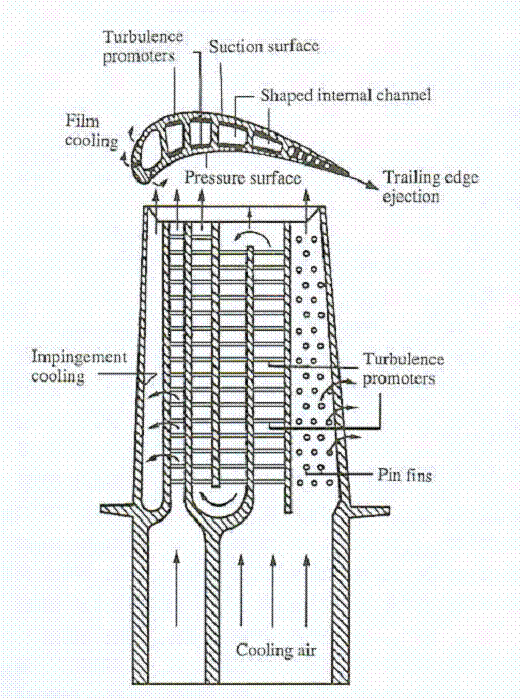
Typical internal cooling arrangement for a multi-pass turbine blade.
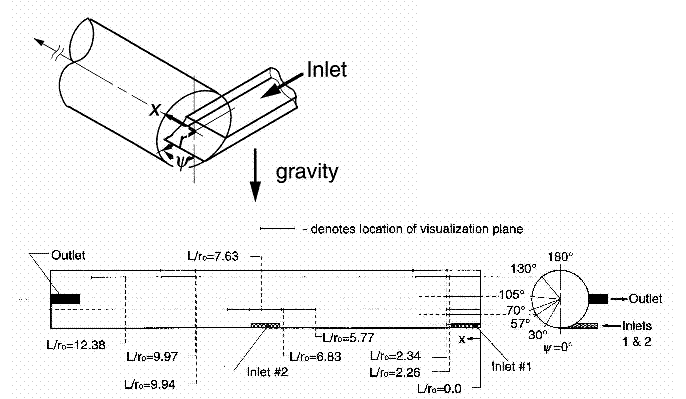
Swirl chamber coordinate system, and schematic drawing
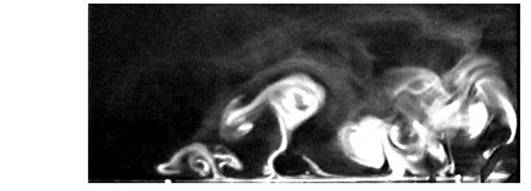
Instantaneous flow image visualized in the axial/radial plane located at ![]() =130° and L/r o =9.94 for Re =5440. Image shows convoluted Görtler vortex pairs positioned between the second inlet and the outlet shown in the above figure.
=130° and L/r o =9.94 for Re =5440. Image shows convoluted Görtler vortex pairs positioned between the second inlet and the outlet shown in the above figure.
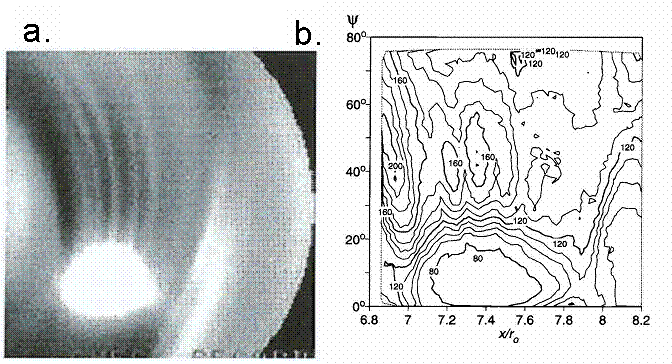
Surface Nusselt number distribution, which shows surface variations due to Görtler vortex pairs for Re =12150 and T oi /T w =0.86 at x/r o =6.8-8.2 and ![]() =0-80 degrees, measured just downstream of the second inlet of the swirl chamber shown in the above figure. (a) Enhanced infrared image. (b) Nusselt number contours.
=0-80 degrees, measured just downstream of the second inlet of the swirl chamber shown in the above figure. (a) Enhanced infrared image. (b) Nusselt number contours.
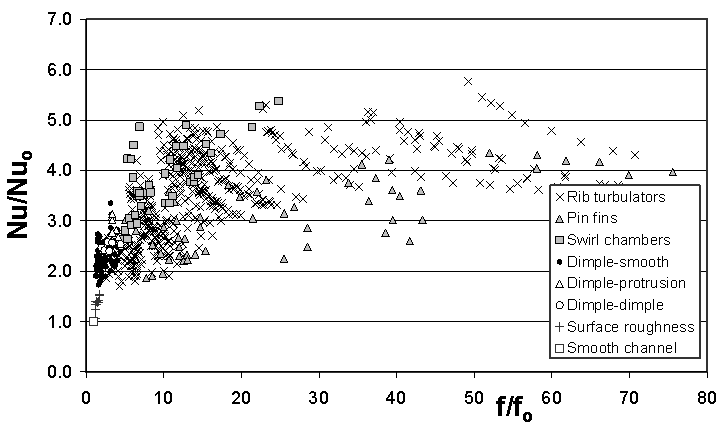
Comparison of relative performance of rib turbulators, pin fins, swirl chambers, dimple-smooth arrangements, dimple-protrusion arrangements, dimple-dimple arrangements, surface roughness, and smooth-walled channels. Globally-averaged Nusselt number ratios are presented as dependent upon channel friction factor ratios.
RECENT PUBLICATIONS:
- Flow Phenomena in Swirl Chambers (P. M. Ligrani, C. R. Hedlund, R. Thambu, B. T. Babinchak, H-K. Moon, and B. Glezer), Experiments in Fluids, Vol. 24, No. 3, pp. 254-264, March 1998.
- Flow in a Simple Swirl Chamber With and Without Controlled Inlet Forcing (R. Thambu, B. T. Babinchak, P. M. Ligrani, C. R. Hedlund, H-K. Moon, and B. Glezer), Experiments in Fluids, Vol. 26, No. 4, pp. 347-357, March 1999.
- Heat Transfer and Flow Phenomena in a Swirl Chamber Simulating Turbine Blade Internal Cooling (C. R. Hedlund, P. M. Ligrani, H.-K. Moon, B. Glezer), ASME Transactions-Journal of Turbomachinery, Vol. 121, No. 4, pp. 804-813, October 1999.
- Heat Transfer in a Swirl Chamber at Different Temperature Ratios and Reynolds Numbers (C. R. Hedlund, P. M. Ligrani, B. Glezer, and H.-K. Moon), International Journal of Heat and Mass Transfer, Vol. 42, No. 22, pp. 4081-4091, November 1999.
- Local Swirl Chamber Heat Transfer and Flow Structure at Different Reynolds Numbers (C. R. Hedlund, and P. M. Ligrani), ASME Transactions-Journal of Turbomachinery, Vol. 122, No. 2, pp. 375-385, April 2000.
- Flow Visualization and Flow Tracking as Applied to Turbine Components in Gas Turbine Engines (P. M. Ligrani), Measurement Science and Technology (special topical issue), Vol. 11, No. 7, pp. 992-1006, July 2000.
- Local Heat Transfer and Flow Structure On and Above a Dimpled Surface in a Channel (G. I. Mahmood, M. L. Hill, D. L. Nelson, P. M. Ligrani, H.-K. Moon, and B. Glezer), ASME Transactions-Journal of Turbomachinery, Vol. 123, No. 1, pp. 115-123, January 2001.
- Heat Transfer in a Channel With Dimples and Protrusions on Opposite Walls, (G. I. Mahmood, M. Z. Sabbagh, and P. M. Ligrani), AIAA Journal of Thermophysics and Heat Transfer, Vol. 15, No. 3, pp. 275-283, July-September 2001.
- Flow Structure Due to Dimple Depressions on a Channel Surface, (P. M. Ligrani, J. L. Harrison, G. I. Mahmood, and M. L. Hill), Physics of Fluids, Vol. 13, No. 11, pp. 3442-3451, November 2001.
- Flow Structure and Local Nusselt Number Variations in a Channel With Dimples and Protrusions on Opposite Walls, (P. M. Ligrani, G. I. Mahmood, J. L. Harrison, C. M. Clayton, and D. L. Nelson), International Journal of Heat and Mass Transfer, Vol. 44, No. 23, pp. 4413-4425, December 2001.
- Heat Transfer in a Dimpled Channel: Combined Influences of Aspect Ratio, Temperature Ratio, Reynolds Number, and Flow Structure, (G. I. Mahmood, and P. M. Ligrani), International Journal of Heat and Mass Transfer, Vol. 45, No. 10, pp. 2011-2020, May 2002.
- Variable Property Nusselt Numbers in a Channel With Pin-Fins, (P. M. Ligrani, and G. I. Mahmood), AIAA Journal of Thermophysics and Heat Transfer , Vol. 17, No. 1, pp. 103-111, January- March 2003.
- Nusselt Number Behavior on Deep Dimpled Surfaces Within a Channel, (N. K. Burgess, M. M. Oliveira, and P. M. Ligrani), ASME Transactions-Journal of Heat Transfer, Vol. 125, No. 1, pp. 11-18, February 2003.
- Comparison of Heat Transfer Augmentation Techniques, (P. M. Ligrani, M. M. Oliveira, and T. Blaskovich) AIAA Journal, Vol. 41, No. 3, pp. 337-362, March 2003.
- Spatially Resolved Heat Transfer and Friction Factors in a Rectangular Channel with 45-Deg Angled Crossed-Rib Turbulators, (P. M. Ligrani, and G. I. Mahmood), ASME Transactions-Journal of Turbomachinery, Vol. 125, No. 3, pp. 575-584, July 2003.
- Flow Structure and Local Nusselt Number Variations in a Channel With Angled Crossed-Rib Turbulators, (S. Y. Won, G. I. Mahmood, and P. M. Ligrani), International Journal of Heat and Mass Transfer, Volume 46, No. 17, pp. 3153-3166, August 2003.
- Variable Property and Temperature Ratio Effects on Nusselt Numbers in a Rectangular Channel With 45 Deg Angled Rib Turbulators, (G. I. Mahmood, P. M. Ligrani, and K. Chen), ASME Transactions-Journal of Heat Transfer , Vol. 125, No. 5, pp. 769-778, October 2003.
- Numerical Predictions of Flow Structure Above a Dimpled Surface in a Channel, (J. Park, P. R. Desam, and P. M. Ligrani), Numerical Heat Transfer, Part A: Applications, Volume 45, Number 1, pp. 1-20, January 2004.
- Comparisons of Flow Structure and Local Nusselt Numbers in Channels with Parallel- and Crossed-Rib Turbulators, (S. Y. Won, and P. M. Ligrani), International Journal of Heat and Mass Transfer, Vol. 47, No. 8-9, pp. 1573-1586, April 2004.
- Spatially-Resolved Heat Transfer and Flow Structure in a Rectangular Channel With Pin Fins, (S. Y. Won, G. I. Mahmood, and P. M. Ligrani), International Journal of Heat and Mass Transfer, Vol. 47, No. 8-9, pp. 1731-1743, April 2004.
- Spatially-Resolved Surface Heat Transfer for Parallel Rib Turbulators With 45 Degree Orientations Including Test Surface Conduction Analysis, (S. Y. Won, N. K. Burgess, S. Peddicord, and P. M. Ligrani), ASME Transactions-Journal of Heat Transfer, Vol. 126, No. 2, pp. 193-201, April 2004.
- Nusselt Numbers and Flow Structure On and Above a Shallow Dimpled Surface Within a Channel Including Effects of Inlet Turbulence Intensity Level, (P. M. Ligrani, N. K. Burgess, and S. Y. Won), ASME Transactions-Journal of Turbomachinery, Vol. 127, No. 2, pp. 321-330, April 2005.
- Numerical Predictions of Flow Structure and Local Nusselt Number Ratios Along and Above Dimpled Surfaces with Different Dimple Depths in a Channel, (S. Y. Won, and P. M. Ligrani), Numerical Heat Transfer, Part A: Applications, Vol. 46, No. 6, pp. 549-570, October 2004.
- Effects of Dimple Depth on Channel Nusselt Numbers and Friction Factors, (N. K. Burgess, and P. M. Ligrani), ASME Transactions-Journal of Heat Transfer, Special Issue – Gas Turbine Heat Transfer, Vol. 127, No. 8, pp. 839-847, August 2005.
- Flow Phenomena in Swirl Chambers (P. M. Ligrani, C. R. Hedlund, R. Thambu, B. T. Babinchak, H-K. Moon, and B. Glezer), Paper 97-GT-530, ASME 42nd International Gas Turbine and Aeroengine Congress and Exposition, Orlando, Florida, June 2-5, 1997.
- Gortler Vortex Acrobatics in a Simple Swirl Chamber (C. R. Hedlund, B. T. Babinchak, P. M. Ligrani, H. Peerhossaini, H-K. Moon, and B. Glezer), 10th Couette-Taylor Workshop, ESPCI, Paris , France , July 15-18, 1997 .
- Heat Transfer and Flow Phenomena in a Swirl Chamber Simulating Turbine Blade Internal Cooling (C. R. Hedlund, P. M. Ligrani, H.-K. Moon, B. Glezer), Paper 98-GT-466, 43rd ASME Gas Turbine and Aeroengine Technical Congress, Exposition, and Users Symposium, Stockholm, Sweden, June 2-5, 1998.
- Local Swirl Chamber Heat Transfer and Flow Structure at Different Reynolds Numbers (C. R. Hedlund, and P. M. Ligrani), Paper 99-GT-164, 44th ASME Gas Turbine and Aeroengine Technical Congress, Exposition, and Users Symposium, Indianapolis, Indiana, June 7-10, 1999.
- Local Heat Transfer and Flow Structure On and Above a Dimpled Surface in a Channel (G. I. Mahmood, M. L. Hill, D. L. Nelson, P. M. Ligrani, H.-K. Moon, and B. Glezer), Paper 2000-GT-230, 45th ASME Gas Turbine and Aeroengine Technical Congress, Exposition, and Users Symposium, Munich, Germany, May 8-11, 2000.
- Rotating and Stationary Rectangular Cooling Passages Heat Transfer and Friction With Turbulators and Dimples, (J. C. Han, P. M. Ligrani, H. C. Chen), Advanced Gas Turbine Systems Research, Aero-Heat Transfer Workshop IV, University of Minnesota, Minneapolis, Minnesota, October 11-13, 2000.
- Rotating and Stationary Heat Transfer and Friction in Rectangular Cooling Channels With Turbulators and Dimples, (J. C. Han, P. M. Ligrani, H. C. Chen), Advanced Gas Turbine Industry Meeting, U. S. Department of Energy, Alexandria, Virginia, December 4-6, 2000.
- Rotating and Stationary Rectangular Cooling Passaages – Heat Transfer and Friction With Turbulators, Pins, and Dimples, (J. C. Han, P. M. Ligrani, H. C. Chen), Turbine Power Systems Conference and Condition Monitoring Workshop, Galveston, Texas, February 25-27, 2002.
- Spatially-Resolved Heat Transfer and Flow Structure in a Rectangular Channel with 45 o Angled Rib Turbulators, (G. I. Mahmood, P. M. Ligrani, S. Y. Won), Paper GT-2002-30215, 47th ASME Gas Turbine and Aeroengine Technical Congress, Exposition, and Users Symposium, Amsterdam, The Netherlands, June 3-6, 2002.
- Rotating and Stationary Rectangular Cooling Passage Heat Transfer and Friction With Turbulators and Dimples, (J. C. Han, and P. M. Ligrani), Aero-Heat Transfer Workshop, SCIES-South Carolina Institute for Energy Studies, Baton Rouge, Louisiana, November 11-13, 2002.
- Nusselt Number Behavior on Deep Dimpled Surfaces Within a Channel, (N. K. Burgess, M. M. Oliveira, and P. M. Ligrani), Paper IMECE2002-32941, 2002 International Mechanical Engineering Congress and Exhibition (IMECE), New Orleans , Louisiana , November 17-22, 2002 .
- Nusselt Numbers and Flow Structure On and Above a Shallow Dimpled Surface Within a Channel Including Effects of Inlet Turbulence Intensity Level, (P. M. Ligrani, N. K. Burgess, and S. Y. Won), Paper Number GT2004-54231, 49th ASME TURBO EXPO Gas Turbine and Aeroengine Technical Congress, Exposition, and Users Symposium, Vienna, Austria, June 14-17, 2004.
- Effects of Dimple Depth on Nusselt Numbers and Friction Factors for Internal Cooling in a Channel, (N. K. Burgess, and P. M. Ligrani), Paper Number GT2004-54232, 49th ASME TURBO EXPO Gas Turbine and Aeroengine Technical Congress, Exposition, and Users Symposium, Vienna, Austria, June 14-17, 2004.
- Numerical Predictions of Heat Transfer and Fluid Flow Characteristics For Seven Different Dimpled Surfaces in a Channel, (J. Park, and P. M. Ligrani), Numerical Heat Transfer, Part A: Applications , accepted for publication, 2004, to appear, 2004 or 2005.
